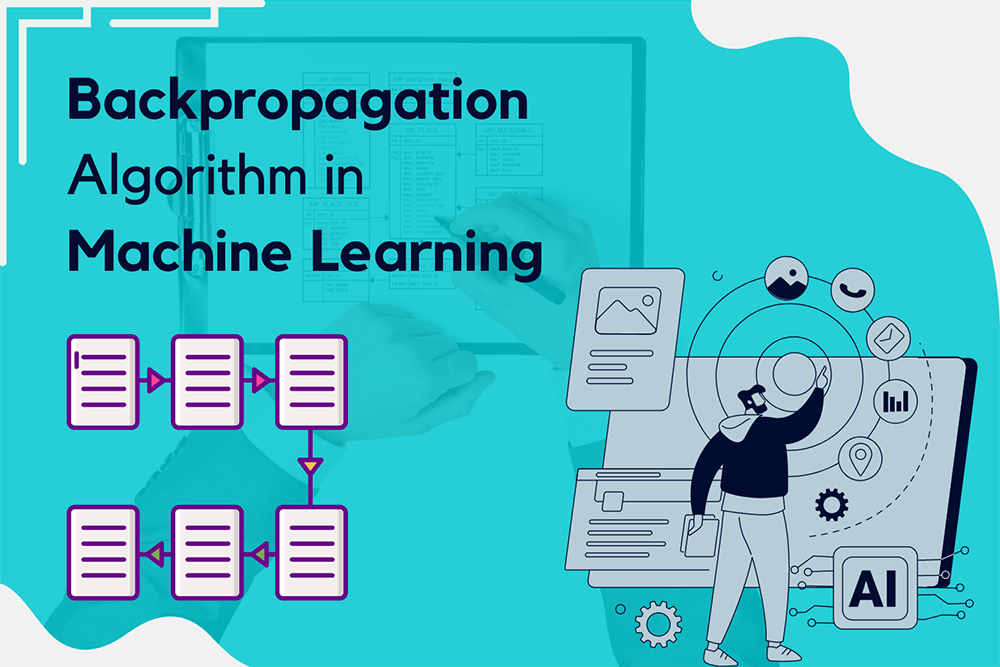Backpropagation algorithm in machine learning is the algorithm which propagates back the error from the output node to input node or hidden nodes in machine learning. It is one of the most commonly used algorithms in machine learning having wide range of applications that includes Signature Verification, Caption generation, Number Plate Recognition, Crack Detection, Character recognition, Digit recognition and many more.
This article is a guide to the Backpropagation algorithm in machine learning, how it works, advantages, disadvantages long with its types.
What are Neural Networks in machine learning?
The human nervous system inspired neural networks, are an information processing model. We have biological neurons in the human nervous system, and artificial neurons in neural networks. The mathematical functions from the biological neurons are known as artificial neurons The human brain is thought to have around 10 billion neurons, each of which is linked to an average of 10,000 other neurons. Each neuron receives a signal via a synapse, which determines the signal’s effect on the neuron.
Backpropagation algorithm in machine learning:
Backpropagation algorithm is widely used in machine learning, in order to train the feedforward neural networks. With respect to the network weights, it calculates the loss function’s gradient which is very efficient when compared to the one which directly computes the gradient with respect to the individual weights. Thus, its easy to train the multi-layer neural networks and their weight updating such that it results in minimal loss with the help of backpropagation algorithm in machine learning.
To prevent unnecessary calculation of intermediate terms in the chain rule, the backpropagation algorithm in machine learning computes the gradient of the loss function with respect to each weight using the chain rule, layer by layer, and iterating backward from the last layer.
To train the neural networks, backpropagation algorithm is uses that is also known as “Backpropagation of Error”. It’s quick, easy to set up, and straightforward. No other parameters are required in the backpropagation algorithm except for the input vectors. Backpropagation is a versatile approach since it requires no prior knowledge of the network.
Working of the backpropagation algorithm in machine learning:
To generate output vectors form input vectors, neural networks employ supervised learning approaches. An error is calculated when the actual output does not match the desired output, i.e., the difference between the actual and the desired output. The weights in the network are adjusted based on the error. Until the desired value is achieved, the process of adjusting weights based on the error continues. This is how the backpropagation algorithm in machine learning works.
Steps for Backpropagation algorithm in machine learning:
Step 1: Input X arrives through the preconnected route.
Step 2: True weights W are used to model the input. Weights are often assigned at random.
Step 3: Each neuron’s output is calculated from input to hidden to the output layer.
Step 4: Calculate the errors between actual and desired outputs with the given formula
Backpropagation error = Actual Output – Desired Output
Step 5: Return to the hidden layer from the output layer to change the weights such that it reduces the error between actual and desired output.
Step 6: Iterate the process until the desired output is obtained.
Types of Backpropagation algorithms in machine learning:
There are mainly two types of backpropagation algorithms in machine learning: Static and Recurrent Backpropagation.
- Static backpropagation: It is a type of backpropagation network algorithm in machine learning that generates a mapping of a static input to a static output. It may be used to address static classification problems for example: Optical character recognition.
- Recurrent backpropagation: In fixed-point learning, the Recurrent backpropagation is used. In recurrent backpropagation algorithms, the activations are fed only in forward direction until they reach a fixed value. The error is calculated and backpropagated once this value is being reached.
Advantages:
- Very simple, easy and fast to program.
- No other parameters are changed or tuned except for the weights in the network.
- One of the most flexible, efficient and widely used machine learning algorithms.
- Used to minimize the cost function hence it is an optimization algorithm
Disadvantages:
- This algorithm is very sensitive towards the noisy data thus leading it to inaccurate results.
- High dependency on input data for evaluating the performance.
- Requires lots of training time.
- Instead of mini batch approach, the matrix-based approach is needed to perform backpropagation.


